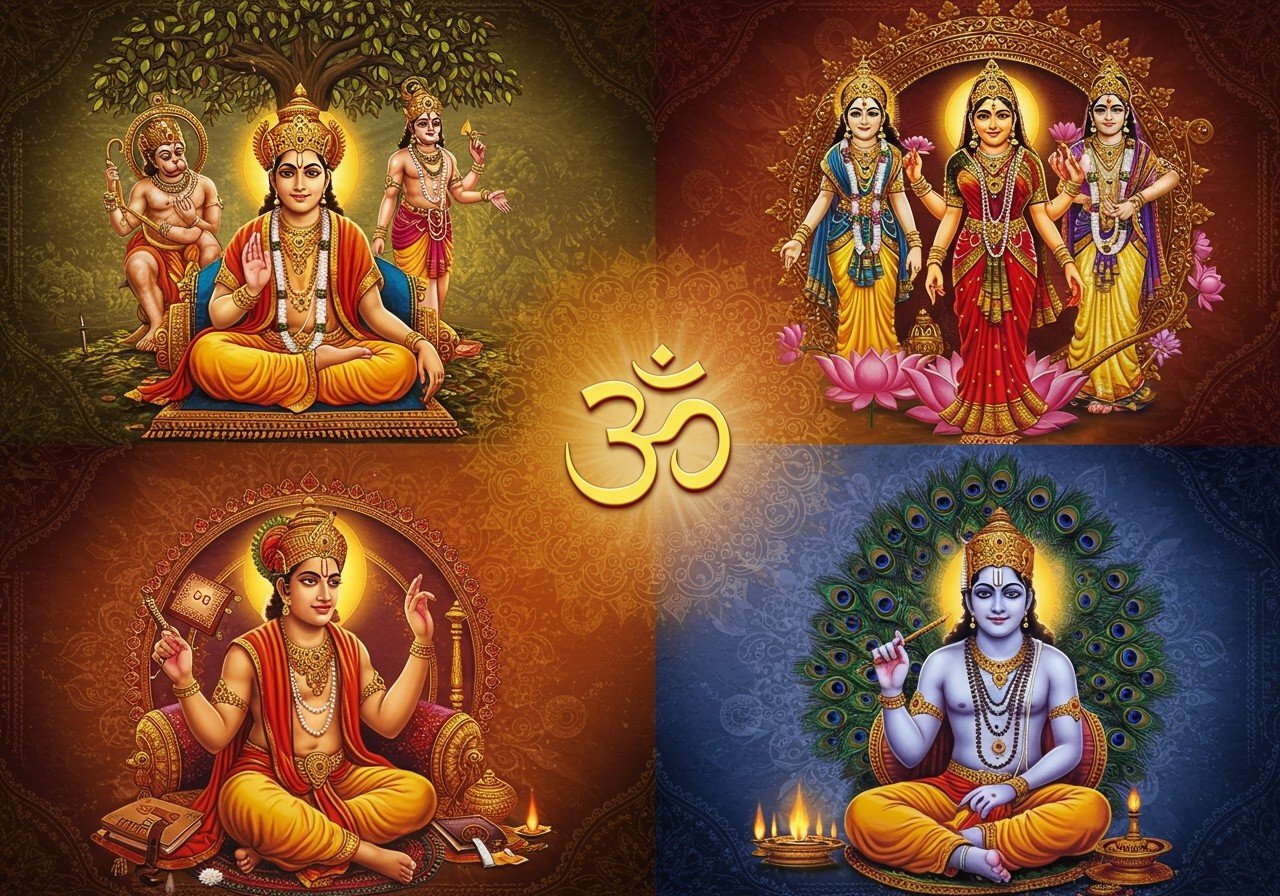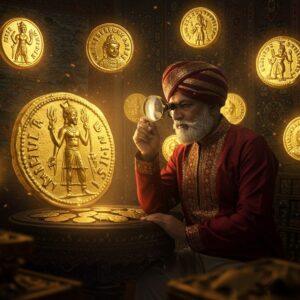
The Four Main Vaishnava Sampradayas are a cornerstone of Hindu tradition. Centered on the reverence of Vishnu and his avatars, these lineages form a vital part of India’s rich spiritual tapestry. This exploration delves into the origins, philosophical underpinnings, and key lineages of these four prominent sampradayas, highlighting their distinctive contributions to the broader Hindu faith. Understanding these traditions offers valuable insights into the diversity within Vaishnavism and its profound influence on spiritual practices across the globe.
Origins of the Four Vaishnava Sampradayas
Each Vaishnava Sampradaya traces its roots back to influential sages and deities. Figures like Ramanuja, Madhva, Nimbarka, and Vishnuswami played pivotal roles in shaping these traditions. Their influence spread across different regions of India, leaving a lasting impact on the cultural and spiritual landscape.
- Ramanuja: Known for his Vishishtadvaita philosophy, Ramanuja’s influence is particularly prominent in Tamil Nadu. He established a system of thought that emphasizes the qualified oneness of the individual soul with the Supreme Being.
- Madhva: A proponent of Dvaita philosophy, Madhva’s teachings are strongly associated with Karnataka. His philosophical system posits a fundamental distinction between the individual soul and God.
- Nimbarka: Credited with developing the Dvaitadvaita philosophy, Nimbarka’s influence is linked to Northern India. His philosophy presents a unique perspective on the relationship between duality and non-duality.
- Vishnuswami: Known for his contributions to Shuddhadvaita, Vishnuswami’s teachings are connected to Gujarat. His philosophy emphasizes the pure non-dual nature of reality.
These traditions find their scriptural basis in sacred texts that continue to guide their teachings. The term ‘sampradaya’ itself signifies a lineage or tradition in Hindu thought, emphasizing the transmission of spiritual knowledge across generations.
Philosophies of the Vaishnava Sampradayas
Each Vaishnava Sampradaya offers a unique philosophical lens through which followers can approach their spiritual journey. The Sri Sampradaya, under the guidance of Ramanuja, embraces Vishishtadvaita. This perspective views the soul and God as distinct yet interconnected, much like a string of beads unified by a golden thread. This philosophy beautifully illustrates the intimate relationship between the individual and the divine.
Brahma Sampradaya, founded by Madhvacharya, adheres to Dvaita philosophy. In this view, God and the individual soul remain eternally separate, like two rivers flowing parallel courses without ever merging. This concept underscores the unique identity of each soul in relation to the Supreme Being.
Rudra Sampradaya, with Vishnuswami and Vallabhacharya as key figures, advocates for Shuddhadvaita. This pure non-dualism perceives God as the ultimate reality, with all other manifestations being essentially one with the divine. It’s akin to an ocean where individual waves are inseparable from the vastness of the water itself.
Lastly, Kumara Sampradaya, established by Nimbarkacharya, practices Dvaitadvaita, a nuanced interplay between duality and unity. This philosophy can be likened to two dancers moving in perfect harmony, distinct yet unified in their expression. This dynamic interplay between individual and divine enriches the spiritual experience.
These diverse philosophies offer various paths towards moksha, or liberation, and significantly influence the religious practices and social values of their followers. They provide frameworks for understanding the nature of reality and the individual’s place within the cosmos.
Lineages and Key Figures
The enduring strength of these sampradayas lies in their lineages, also known as guru-parampara. Each tradition boasts a rich history of spiritual leaders who have diligently passed down wisdom and teachings through the generations, preserving the essence of their respective philosophies.
Within the Sri Sampradaya, Ramanuja’s successors have played a vital role in continuing his work, establishing temples that serve as living embodiments of his teachings and providing spiritual guidance to countless followers.
Brahma Sampradaya has seen the preservation of Madhvacharya’s legacy through the dedicated efforts of his disciples. They have authored important texts and established mathas, monastic centers that serve as hubs for learning and spiritual practice.
In Rudra Sampradaya, Vallabhacharya’s followers have spread his profound message through the mediums of devotional poetry and music, making his teachings accessible and deeply moving for a wide audience.
Kumara Sampradaya relies on the wisdom passed down by Nimbarkacharya’s successors, who celebrate devotion through vibrant festivals and meaningful rituals, fostering a sense of community and shared spiritual experience.
Each lineage diligently maintains continuity by nurturing the sacred bond between teacher and disciple, ensuring that the wisdom and teachings of the founders continue to inspire and guide future generations.
Cultural and Social Impact
The Vaishnava Sampradayas have profoundly shaped Indian culture and society. The temples constructed by Ramanuja’s followers stand as architectural marvels, seamlessly blending artistic expression with spiritual significance. These temples also serve as important community centers, promoting social harmony and shared values.
The music and dance traditions fostered by the Brahma Sampradaya resonate with deep devotion. Compositions rich in spiritual meaning inspire worship and introspection, uniting communities through shared artistic experiences.
Festivals celebrated within the Rudra Sampradaya, such as Janmashtami, transform cities into vibrant expressions of faith and love. Pilgrimages to sacred sites bring people from diverse backgrounds together in shared devotion, strengthening social bonds and reinforcing a sense of collective identity.
The Kumara Sampradaya has made significant contributions to the Bhakti movement, emphasizing the importance of heartfelt devotion over mere ritualistic observance. This approach fosters a more personal and intimate connection with the divine.
Modern Relevance and Global Influence
Even in today’s world, the Vaishnava Sampradayas continue to hold deep relevance. Organizations like ISKCON have played a crucial role in introducing Vaishnavism to a global audience, adapting its teachings to diverse cultural contexts while carefully preserving their authenticity.
Digital platforms have become invaluable tools, providing access to scriptures, lectures, and rituals, making spiritual learning more convenient and accessible than ever before. While navigating the complexities of balancing tradition with modernity presents ongoing challenges, these sampradayas demonstrate remarkable resilience by embracing change without compromising their core values.
By understanding these rich traditions, we gain a deeper appreciation for a faith that has nurtured devotion, unity, and ethical living for centuries. They offer valuable insights into the human quest for meaning and connection with the divine.
How Poojn.in Supports Your Vaishnava Traditions
Poojn.in offers a wide selection of authentic puja items for followers of all four main Vaishnava Sampradayas. As India’s largest Dashakarma Bhandar, we provide essential items for Vaishnava worship and rituals:
- Tulsi Mala: Sacred prayer beads crafted from genuine tulsi wood, essential for japa and meditation across all Vaishnava traditions. Find your perfect Tulsi Mala here.
- Shaligram Shila Care Items: Specialized products designed for the proper maintenance and worship of your Shaligram Shila, ensuring reverence and respect for this sacred symbol.
- Vishnu Puja Sets: Comprehensive sets containing all the necessary items for conducting daily Vishnu puja, simplifying your practice and enhancing your devotion. Explore our Vishnu Puja Sets.
- Pure Copper Items: Traditional vessels and items crafted from pure copper, used in various Vaishnava rituals, adding authenticity and tradition to your practice.
- Sandalwood Tilak: Authentic sandalwood paste for applying Vaishnava tilak marks, a symbol of devotion and spiritual connection.
- Brass Lamps: Traditional deepams, or lamps, for aarti ceremonies, illuminating your sacred space and enhancing the devotional atmosphere. Find beautiful Brass Lamps at Poojn.in.
Our products adhere to strict Shastric guidelines and are sourced from verified traditional artisans. Each item comes with detailed care instructions and basic puja vidhi guidelines to support your practice.
Visit www.poojn.in to explore our complete collection of Vaishnava puja items. We offer secure packaging and delivery across India to help you maintain your sampradaya traditions with authentic materials.
Embracing Tradition and Modernity
The Vaishnava Sampradayas, with their profound philosophies and vibrant practices, act as a bridge connecting us to centuries of accumulated wisdom. They illuminate our understanding of the divine and our own place within the vast cosmic order. Each sampradaya, with its unique teachings and lineages, enriches our spiritual journey, offering pathways to moksha that resonate with the rhythm of our lives.
In our ever-evolving world, these traditions serve as anchors, reminding us of the enduring values of devotion, unity, and ethical living. They inspire us to cherish our heritage while embracing the conveniences of modern life. Whether through digital platforms or global communities, Vaishnavism continues to flourish, sharing its timeless message of love and devotion worldwide.
As we honor these sacred traditions, we find solace and strength in knowing we are part of a greater tapestry of faith. The Vaishnava Sampradayas invite us to embark on a journey of self-discovery, cherishing our cultural roots and carrying the light of wisdom forward for generations to come.
FAQs on The Four Main Vaishnava Sampradayas
What are the four main Vaishnava Sampradayas? The four main Vaishnava Sampradayas are Sri Sampradaya, Brahma Sampradaya, Rudra Sampradaya, and Kumara Sampradaya. Each sampradaya is distinguished by its unique origins and philosophical perspectives.
Who founded the Sri Sampradaya? The Sri Sampradaya was founded by Sri Ramanuja, a revered philosopher and theologian. It emphasizes the worship of Lord Vishnu and his consort, Goddess Lakshmi.
What is the philosophy of the Brahma Sampradaya? The Brahma Sampradaya, founded by Madhvacharya, upholds the philosophy of dualism. This philosophical system focuses on the inherent difference between the individual soul and God, coupled with a profound devotion to Lord Krishna.
Why is the Rudra Sampradaya important? The Rudra Sampradaya, initiated by Vishnuswami, holds significance due to its emphasis on pure devotion (bhakti) and the worship of Lord Krishna as the Supreme Personality of Godhead.
How does the Kumara Sampradaya differ from others? The Kumara Sampradaya, under the guidance of Nimbarkacharya, distinguishes itself by teaching a nuanced blend of dualism and non-dualism, with a particular focus on the divine couple Radha and Krishna.
What role does ISKCON play in the four Vaishnava Sampradayas? ISKCON, a prominent contemporary movement, is affiliated with the Brahma Sampradaya. It follows the teachings of Madhvacharya and actively promotes the worship of Lord Krishna across the globe.
Are there any similarities among the four Vaishnava Sampradayas? Yes, despite their philosophical differences, all four Sampradayas share a common thread: they emphasize devotion to Lord Vishnu or his avatars, particularly Krishna, and adhere to the principles of bhakti (devotion) and the importance of the guru-disciple lineage.
You can explore more about Krishna’s life and teachings at Krishna’s Birthplace, Childhood, Dwarka: A Complete Life Exploration, Krishna’s Names, Meaning and Significance in Hinduism, and Krishna and Radha: The Story of Divine Love.

